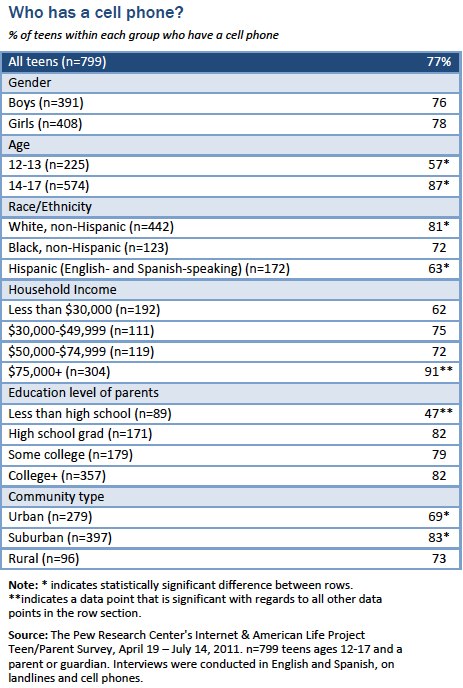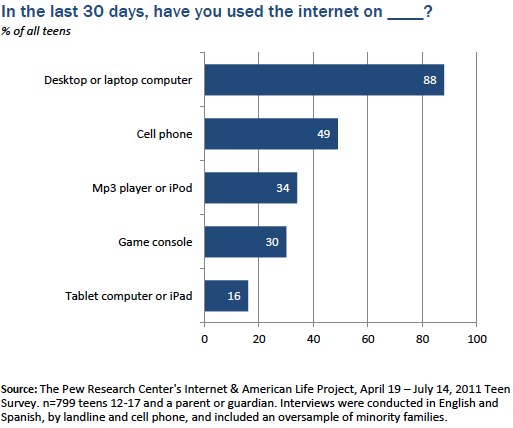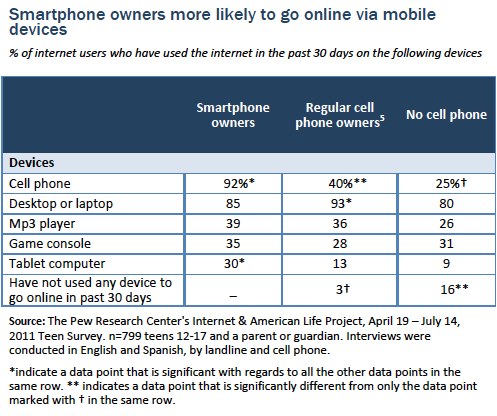Overall cell ownership steady since 2009
According to the Pew Internet Project’s 2011 teen survey, three quarters (77%) of teens have a cell phone, a figure that is similar to the 75% of teens who owned a cell phone in September 2009 and up dramatically from the 45% of teens who were cell owners in late 2004.
Older teens ages 14 to 17 are substantially more likely to have a cell phone than younger teens ages 12 and 13 – 87% of older teens have a cell phone, compared with 57% of younger teens. Since 2009, the number of older teens with mobile phones has increased from 80%, while the percentage of younger teens with cell phones has declined slightly, from 66% in 2009.
In 2011, the youngest boys are the least likely of the groups to have a mobile phone – just under half (47%) have a cell phone, compared with 67% of girls 12 to 13 and 85% of older girls and 88% of older boys. There are no differences in phone ownership between boys and girls overall, as was the case in 2009 as well.
White teens are more likely to have a cell phone than Latino teens (81% vs. 63%). Teens with parents who have a high school education or greater are more likely than teens whose parents lack a high school diploma to have a cell phone. And teens from the highest income households – where families earn more than $75,000 annually – are more likely than any other income bracket to own a mobile phone. Suburban teens are more likely than urban teens to have a mobile phone (83% vs. 69%). Teen social media users are more likely than others to have a mobile phone (82% have one vs. 69% of those who do not use social media).

23% of teens have a smartphone
One quarter (23%) of teens 12 to 17 indicate that their phone is a smartphone, while 54% have a regular cell phone (or are not sure what kind of phone they have), and another 23% of teens do not have a cell phone at all. Using a different series of questions to measure smartphone ownership,3 we found that 46% of adults report having a smartphone of some kind in early March 2012.
Smartphone ownership is highest among older teens, as 31% of teens ages 14-17 have a smartphone, compared with just 8% of youth ages 12-13. The data suggest a cell phone ownership evolution by age. The youngest teens are the least likely to own a cell phone of any kind at all. Early high-school aged teens (14 and 15-year-olds) are much more likely to have a cell phone, but that phone is more likely to be a regular phone than a smartphone. The oldest high schoolers (16 and 17-year-olds) are the most likely to have a cell phone, and have that cell phone be a smartphone, though even they are still somewhat more likely to have a regular phone than a smartphone. Teens with parents with a college education are slightly more likely than teens with parents with a high school diploma or less to have a smartphone (26% vs. 19%).
As with adults, smartphone-owning teens are avid users of a number of social media applications—91% of teen smartphone owners use social networking sites, and 25% are Twitter users compared with 77% of teens without smartphones who use social network sites and 13% who use Twitter.
While there are no differences in ownership of smartphones compared with regular cell phones by race, ethnicity or income, some groups do express more uncertainty about whether their phone should be classified as a smartphone. Latino youth with cell phones are more likely than white youth with cells to say they are not sure whether their phone is smartphone (24% of Latino youth with cell phones say they are not sure, compared with 10% of white teens with phones). Among cell phone owners, teens from families earning less than $30,000 annually and teens with parents without college experience are both more likely to say they’re not sure whether their phone is a smartphone or not.
Smartphone owners are much more likely than other teens to have gone online on mobile phones & tablets in the last 30 days.
Overall, half (49%) of all American teens have gone online on their mobile phones in the last 30 days. Not surprisingly given the affordances of the technology they possess, a whopping 92% of teen smartphone owners have gone online in the past 30 days on a cell phone. Comparatively, 40% of teens with regular cell phones have used a cell phone to go online in the last 30 days. Even a quarter of teens who do not have their own cell phone have used one to go online in the last month – potentially by borrowing the phone of a friend, parent or sibling.

Smartphone-owning teens are also substantially more likely than other teens to have used a tablet computer to go online in the last 30 days; 30% of smartphone users have used tablets to go online in the past month, while 13% of regular phone users and 9% of those without cell phones have done the same.4
Smartphone owners are also a hair less likely than teens with other types of cell phones to have used the internet on a desktop computer in the last 30 days, with 93% of regular phone owners using a desktop or laptop, along with 85% of smartphone-owning teens.
There are no differences by phone ownership in internet use on a game console or on an mp3 player.

Parents of teen smartphone owners are no more or less likely than other parents to use parental controls to manage their child’s mobile use and mobile internet use.
As cell phones increasingly have the capability to connect to the internet, mobile phone providers have begun to offer parental controls to allow parents to manage or constrain their child’s mobile phone use. Among all parents of teen cell phone users, 34% report using parental controls to help them manage their child’s use of his or her cell phone. Just over a quarter (28%) of the parents of smartphone owning-teens say they have enabled parental controls on their child’s phone, while 37% of parents with teens with regular mobile phones use parental controls. The difference in parental control use between smartphone parents and regular phone parents is not statistically significant.




